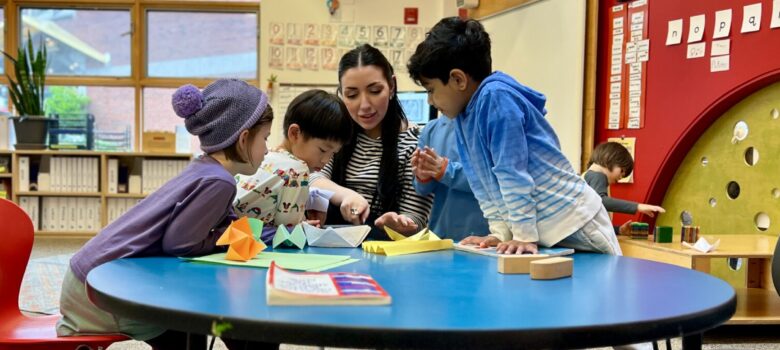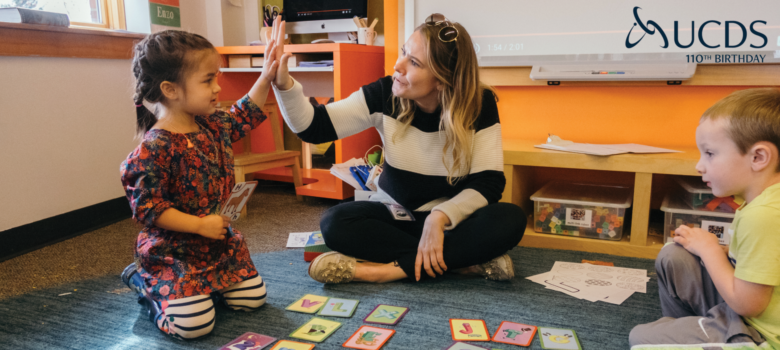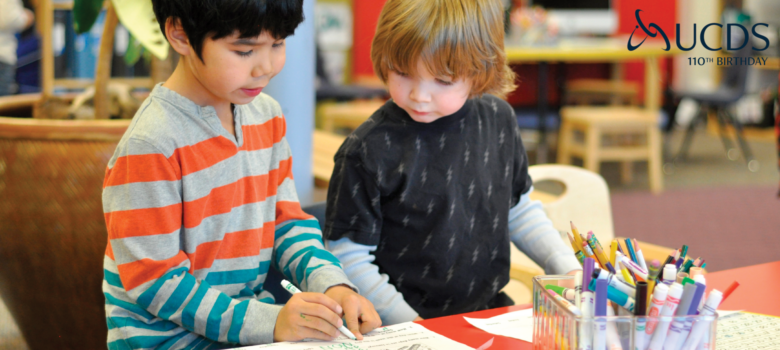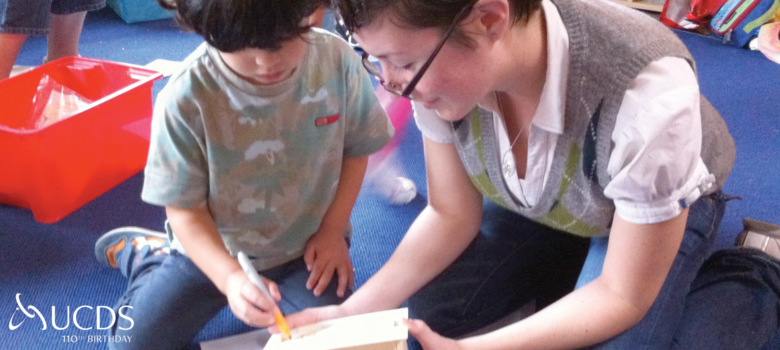By Marianne Sardelich, Infant Toddler Program Curriculum Coordinator
If someone had told me in early March that I would be leading weekly Zoom meetings with one, two, and three year olds from our Infant/Toddler program, I would have probably asked, “What is Zoom?”
That is how unprepared I was for our new reality of distance learning. I didn’t even know what Zoom was before our school closed. I’ve been on a steep learning curve since and I feel like it is a good time to reflect on what I have learned.
I am the Curriculum Coordinator at the UCDS Infant/Toddler Education Program. Together with classroom teachers, I co-plan and facilitate weekly small group meetings with students who range from one year to three years old. Our small group program is called Exploring Relationships and Connections and during the meetings, groups of four or five students work on projects centered around a specific exploration theme. When we left school, five distinct groups were meeting every week and exploring topics such as collaboration, math, and artistic expression. When our school closed, we began developing curriculum for parents and children to access online. In trying to transfer ERC experiences to a distance learning model, I created project sheets with lots of ideas for ways that parents could continue their child’s ERC group exploration at home. Almost immediately, though, I felt I was not adapting to our unique situation in a way that would be meaningful for our students. I quickly realized that the heart of ERC groups is the experience that children have while exploring something together, so I turned my attention to planning and facilitating weekly ERC Zoom meetings.
Through leading these weekly meetings, I generated a mental list of things that I’ve learned about teaching young children over Zoom. Because our school still has a month of Zoom meetings in its future, I thought I should share my ruminations in the hopes of starting a conversation about how to best teach young children using this new medium.
My first thoughts are focused on ideas that I think are important for teachers.
The Mute Button: How many times have we as teachers dreamed of being able to press a button and mute our whole class? Having the chance to speak without interruption for as long as you like seems like a wish come true and yet I have noticed that it also tends to cause students to check out. For our younger age group, we found it almost impossible, especially at the beginning of holding Zoom meetings, to convey any information without having all the children talking at once. The speaker screen would hop around to all the students at a frenzied pace. There is also the problem of background noise, which is challenging to mitigate and can easily make it hard for us to hear one another. So, naturally, we started using the mute button and it made sharing our thoughts so much easier. We quickly found, though, that we were missing the student interactions that make activities like book reading dynamic. It was hard to know when children were sharing thoughts or wanted to add to the discussion. While it is important that every child is able to access information, I worry it won’t be meaningful if they don’t have a chance to discuss it with one another. I’m trying to be very thoughtful about when I use the mute button. In planning, I try to predict how children will respond to a project. If the experience will be enhanced by children reacting and engaging in it as a group or if children will be deterred by not being able to hear what is going on.
Fostering Child to Child Conversations: Thinking about the impact that the mute button might be having on student experience also helped me to realize why it might be so hard for students to keep themselves from starting side conversations. During a regular school day, students have hours to talk with their friends and teachers about anything and everything. Now there is just a very short window of time when students get to see and interact with their friends and teachers, especially young children who are not able to navigate calling friends themselves. They have so much to say to one another and at the same time having these unstructured conversations over a screen is tricky. I’m scheduling time for students to talk with one another and I am trying to facilitate these conversations by re-asking questions, prompting responses, and sharing information. By supporting and encouraging these “side” conversations, we are helping children to maintain and continue to develop their relationships with classmates and teachers.
Try to Make Room for Play: My final thought about Zoom meetings is obvious and yet, I think, is worth repeating again and again: make room for play. The majority of the learning that young students do and the skills that they develop take place as a result of playing together. Social-problem solving skills are probably the hardest to develop if you are mainly playing alone or with younger siblings. Older siblings might help younger siblings to develop these skills even faster. In my opinion, though, collaborative play is the hardest thing to foster during a Zoom meeting. It is easy to be playful over Zoom but it is challenging for children to actually play with one another. With everyone working in their own spaces, it is hard to make a shared plan, there is little need for negotiation or turn-taking, there are no consequences for not following the “rules”, and if you don’t want to do something you can just walk away from the screen. I’ve found that the best way to practice some of these skills is through games. My son’s favorite is “Hide and Seek”. “Hide and Seek” has a structure to follow, it is important that participants follow the “rules”, roles are shared and played by each child who participates, and there is some room to adapt plans according to the whims of the players. Playing collaborative games like “Hide and Seek” will hopefully help keep students’ social problem solving skills alive during a time when they might have limited opportunities to use them.
Continued in the next blog…





